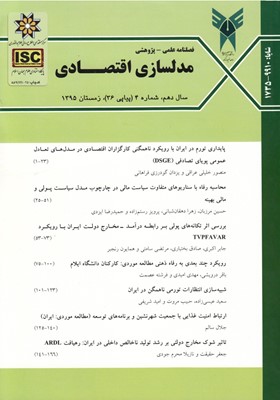میزان قدرت بازاری صنعت بیمه در ایران (کاربرد هال - راجر)
محورهای موضوعی : اقتصاد کار و جمعیت
جعفر یوسفی
1
,
مهدی مرادی
2
*
![]() ,
سید یوسف حاجی اصغری
3
,
رستم قره داغی
4
,
سید یوسف حاجی اصغری
3
,
رستم قره داغی
4
1 - دانشجوی دکتری گروه اقتصاد، دانشکده علوم انسانی، واحد میانه، دانشگاه آزاد اسلامی ، میانه، ایران
2 - استادیار گروه اقتصاد، دانشگاه پیام نور، تهران، ایران
3 - استادیار گروه مدیریت،دانشکده علوم انسانی، واحد میانه، دانشگاه آزاد اسلامی، میانه، ایران
4 - استادیار گروه مدیریت، دانشکده علوم انسانی، واحد میانه، دانشگاه آزاد اسلامی، میانه، ایران
کلید واژه:
چکیده مقاله :
هدف از مقاله برآورد درجـه توافـق و میـزان قـدرت بازاری صـنعت بیمه با استفاده از رویکرد هال - راجر در قالب معادلات عرضه و تقاضا با کمک داده پانل به روش حداقل مربعات دومرحلهای است. بدینمنظور، اطلاعات 27 شرکت بیمهای (دولتی و خصوصی) در ایران طی سال های 1380-1399 استفاده شد. نتایج حاکی از وابستگی متقابل شرکت های صنعت بیمه و سطح بالای توافق و قدرت بازار در این صنعت است؛ بهطوری که بیش از 85 درصد شرکتهای بیمه مورد بررسی با ایجاد شکاف بین قیمت و هزینه نهایی توانستهاند از حاشیه سود قابلتوجهی برخوردار شوند. همچنین، نتایج محاسباتی مربوط به شاخص لرنر براساس مدل هال - راجر اطلاعات مربوط به ضریب ناهمگونی در بین شرکتهای بیمه را نشان میدهد. بیمه ایران با ضریب 565/0 دارای بالاترین شاخص لرنر بوده و بیمههای آسیا، دانا و پاسارگاد بهترتیب، با 419/0 و 248/0 و 182/0 در رتبههای بعدی قرار دارند؛ این بدینمعناست که این شرکت ها بهدلیل فاصله قیمت تا هزینه نهایی بیشترین حاشیه سود را کسب کردهاند. براساس نتایج، در صنعت بیمه ایران سرمایهگذاری بیشتری در فعالیتهای بازاریابی، ارائه خدمات نوین بیمهای مناسب با شرایط و نیاز جامعه ایجاد و گسترش آن، پیشنهاد میگردد.
Estimating the amount of market power and determining the market structure of various industries is one of the most important topics in microeconomics,because the amount of production and price of various goods and services is affected by the degree of monopoly and market power of that industry.The purpose of this research is to estimate the degree of agreement and the levelof market power of the insurance industry using the Hall-Roger approach in the form of supply and demand equations with the help ofpanel data using the two-stage least squares method.For this purpose,the information of27public and private insurance companies In addition to the large share of their financial market in employment, the insurance industry is closely related to the characteristics of savings and the level of economic development of countries, and as one of the tools of risk management, it provides the expansion of social welfare on the one hand, and on the other hand It leads to the growth of investment and, as a result, more production and economic prosperity.As expected,the research results indicate the mutual dependence of insurance industry companiesSo that more than 85%of the investigated insurance companies have been able to enjoy a significant profit margin by creating a gap between the price and the final cost.Also the calculation results related to theLerner index based on theHall model show the information related to the coefficient of heterogeneity among insurance companies.Iran insurance has the highest Lerner index with a coefficient of0.565andAsia,Dana andPasargad insurances are in the next ranks with0.419,0.248and0.182respectively,

